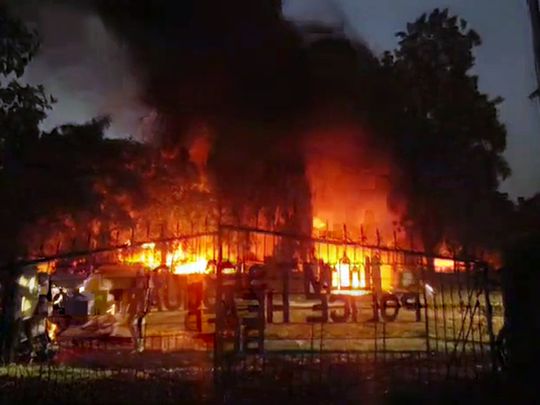
In India, the Maratha community’s long-standing demand for reservations under the Other Backward Classes (OBC) category is now a fait accompli.
Some 700,000 Marathas in Maharashtra are eligible for the OBC caste certificate as Kunbis following the recommendations of the Justice Sandeep Shinde committee. This was announced by Eknath Shinde’s Maharashtra government (an alliance of breakaway Shiv Sena faction and BJP) on October 31.
The Maratha demand for reservations has turned violent several times in the past. This time too, several parts of the Marathwada region have been under curfew after outbreaks of rioting and arson.
As a significant vote bank, Maharashtra politics cannot afford to ignore or overlook Maratha ultimatums. Has the Shinde government now found the formula to appease this key constituency in their support base?
Unfortunately, we cannot be sure. Maratha reservation activists are not satisfied with the partial concession. Jarange Patil, on a hunger strike for 17 days, reportedly sipped some water as a symbolic gesture to end his fast after receiving a phone call from Chief Minister Shinde.
A cohesive political community
But the Maratha demand for the entire community, not just those identified as Kunbis in the erstwhile Nizam of Hyderabad’s territories, is yet to be met. Patil threatened to resume his fast if the government did not extend the reservations to all Marathas in the state.
In 2021, the Supreme Court of India struck down additional reservations for Marathas, ruling that there was no proof of backwardness. Not entirely surprising because Marathas are not only the dominant political community in Maharashtra that has produced several prominent political leaders but also the erstwhile ruling feudal lords.
In fact, since the formation of the state in 1960, 12 of Maharashtra’s 20 chief ministers have been Marathas. The incumbent, Shinde, is one too.
Marathas range from modest peasantry to titled dynasts. Yet as a somewhat cohesive political community, they control massive assets, including land, sugar mills, and industries in Maharashtra.
With at least 700,000 Marathas in Maharashtra being assured of the OBC status and more probably to follow, the ability of powerful regional communities to use reservations to gain control of the state’s resources has just received a fillip.
Constitutional guarantee
Never mind that the Constitutional guarantee of reservations was initially only for the most disadvantaged sections, India’s scheduled caste and scheduled tribes.
Now, Marathas, who pride themselves on ruling much of India after the great Shivaji raised the mantle of revolt against the mighty Mughal empire, have fought and virtually secured the tag of backwardness.
It would seem that in addition to their social and historical prestige as warriors, saviours, and liberators of Maharashtrians from the Mughal yoke, they have also ensured that they and their descendants will derive preferential benefits in education, jobs, and other state-mandated sops.
The Maratha quota has been criticised as a political move to appease a dominant and influential community with a strong presence in the state’s politics, economy and culture. Marathas also comprise about 32 per cent of the state’s population.
To offer additional reservations to the Marathas, who already enjoy 12 per cent reservations in education and 13 per cent in government jobs, as recommended by the State Backward Class Commission, would seriously skew the current quotas in the state.
Subdivisions and sub-quotas
The latter currently stands as follows in the state: Scheduled Castes 13 per cent, Scheduled Tribes 7 per cent, OBCs 19 per cent, Special Backward Classes 2 per cent, Vimukta Jati 3 per cent, Nomadic tribe (B) 2.5 per cent, Nomadic Tribe (C) Dhangar 3.5 per cent, and Nomadic tribe (D) Vanjari 2 per cent.
Confusing? Indeed! To all except insiders to this complicated, controversial, and competitive system of extracting benefits and guarantees from the state. But let us try to clarify the Maharashtra’s quota conundrum by asking what the latest move on the caste chessboard means.
To put it bluntly, the Maratha reservation would not just be a dilution but a fundamental alteration of the affirmative action process in India. In the fight between the caste system and affirmative action, the former has won.
But in ways that are curiously contradictory and difficult to revoke. Reservation has come to mirror the caste system, which it was originally designed to upend. Reservation is now India’s new caste system.
Even the only group excluded, the so-called forward or upper castes, have the de facto up to 50 per cent “general quota.” But anyone, including those who have benefits in caste quotas, can compete in this open allocation. In other words, India now has two main slots, open and reserved, with subdivisions and sub-quotas in both.
For instance, in the general slot, there is a reservation for economically weaker sections earmarked for the poor among the upper castes.
With such profound shifts, the reservation policy in India will only become more complex and controversial. There will be more demands and pressures from various “forward” groups such as Jats and Patels for reservations or sub-quotas within reservations. This may lead to legal challenges and political conflicts over the constitutional validity and feasibility of reservations.
The Maratha reservation may also raise questions about the rationale and relevance of reservations in a changing society where caste is not the only factor of disadvantage or discrimination.
Additionally, it may divert attention from addressing the root causes of backwardness, such as poverty, illiteracy, malnutrition, health care, and infrastructure, among others, which affect all sections of society irrespective of caste.









